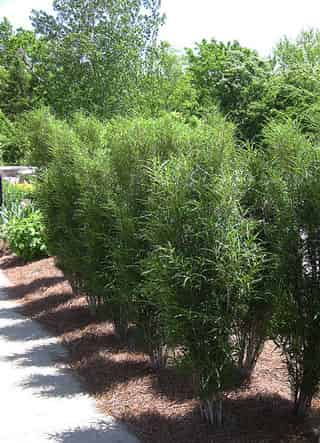Resource Library
Plant of the Week: Buckthorn , ‘Fine Line’
The University of Arkansas System Division of Agriculture does not promote, support or recommend plants featured in "Plant of the Week." Please consult your local Extension office for plants suitable for your region.

‘Fine Line’ Buckthorn
Latin: Rhamnus frangula
Selling stuff to a mass market is fascinating to watch from the sidelines. Sometimes
it involves frivolous things no one would never need – think Pet Rocks® – or other
times it can be a game changer such as Apple’s iPhone.
The nursery industry does the same thing with several companies specializing in identifying,
promoting and mass marketing “new” plants for a national audience. Fine Line® buckthorn
(Rhamnus frangula ‘Ron Williams’ PP14791) is such an example and the verdict is still
out on where it lies on the frivolous – useful continuum.
What is Fine Line Buckthorn?
Fine Line buckthorn is a deciduous columnar plant growing 6 to 8 feet tall and about
two feet wide. It is freely branching from the base with ascending branches that bear
gracefully arching willowy leaves that are glossy green and to 5 inches long. In the
fall they develop an attractive yellow fall color.
The tiny yellowish-green flowers are produced in mass in the leaf axils after the
foliage has appeared in the spring so are seldom ever noticed, except perhaps by the
bees which seem to love them. In the typical buckthorn the pea sized fleshy fruit
appears in late summer, first as in shades of red and then turning purplish-black
as they mature. Fruit production, unlike most buckthorns, is low for Fine Line and
seeds that are produced are said to be mostly nonviable. In one trial the species
germinated at 98 percent while Fine Line had only 3 percent germination.
The genus Rhamnus, which belongs to its own family, consists of about 150 species
with near world-wide distribution. In Arkansas the most common native species is Carolina
buckthorn (R. caroliniana)which is reported statewide with the exception of a few
eastern counties.
Glossy buckthorn, the parent of Fine Line, was introduced into the United States a
couple hundred years ago from Europe as an ornamental for northern climates where
winter temperatures routinely reach -30 degrees Fahrenheit. Being not especially ornamental
but highly adaptable, it eventually escaped into the wilds in the upper Midwest and
parts of Canada. Over the years a couple cultivars were selected. One – ‘Columnaris’
– was a fastigiate form that was highly promoted in the 60s and 70s as “Tallhedge
Glossy Buckthorn” as a hedge plant for expanding suburbia in cold climates. Another
cultivar, the willowy leafed ‘Asplenifolia’, had a rounded form but more attractive
foliage.
Where did Fine Line Buckthorn come from?
In 1989 Ron Williams, a hosta collector and nurseryman in Green Bay, Wisc., identified a unique seedling buckthorn from an accidental cross between the two buckthorn cultivars growing in his garden. It combined the columnar form of Tallhedge, the female parent, with the lacy foliage of the male. A decade later this plant was propagated by cuttings and in 2003 the plant patent was licensed to Spring Meadows Nursery in Michigan. From there it was selected as one of the Proven Winner® plants and debuted for national distribution.
Fine Line Buckthorn Care
Fine Line is easily grown in full sun or light shade in any reasonable garden soil. It can be used in narrow spaces for hedging or as a backdrop for flowerbeds or as a standalone specimen. Time will tell if this deciduous plant – one that seems to have real merit in colder climates – has a place in southern gardens where a number of columnar evergreen plants can perform the same function.
By: Gerald Klingaman, retired
Retired Extension Horticulturist - Ornamentals
Extension News - February 7, 2014